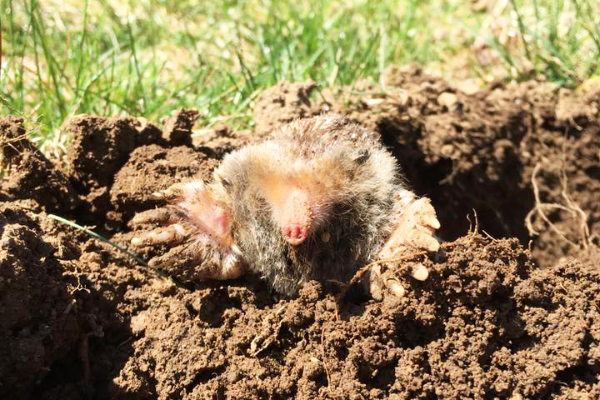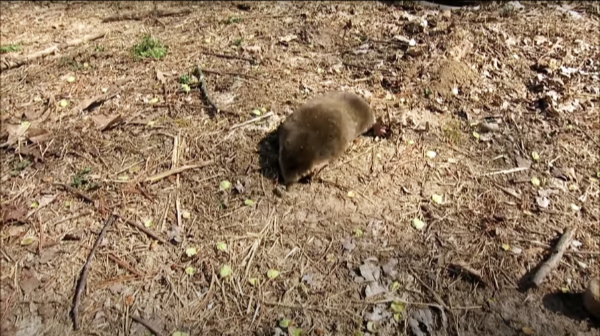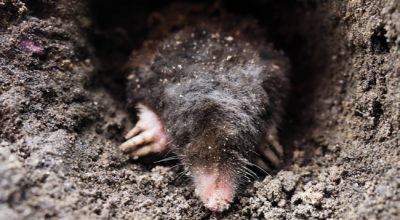Identification
Moles (the wild animal)
Moles get falsely mistaken all the time for rodents like mice or voles when they’re actually not. They are rarely ever spotted above ground and primarily live underground. Sometimes, the only form of identification that they leave behind is their digging tracks.
However, this seemingly harmless small creature is extremely important to identify and spot because of the extensive damage that they can cause on lawns. You must be aware of how these moles look to better distinguish them from other pests that may be found in your property or yard.
Appearance

Moles have distinguishing features like their oversized feet as compared to the rest of their petite body and large hands that aid them greatly in their mission to dig underground and through the soil. Their fur is soft, and the color varies from brown to dark gray and they have protruding snouts. Their bodies are roughly about the size of a small potato and they are generally strange looking creatures. Although they rarely eat plants and mostly survive on worms and other insects, the damage they mainly cause to your lawns is due to extensive digging, which comes out in the form of cracks in the soil. But in some cases, moles break up the land allowing plants to grow at an even better rate.Moles, as common as they are, go undetected most of the time even though they practically dig through their lives, but here are more factors that may help you identify their presence:
Mole Sounds
Moles are nocturnal creatures; they spend most of their time below the surface and nearly sleep up to ten hours a day, so it’s understandable why you may not notice one. But, the noises they make can help you easily tell them apart from other animals. Moles are known to make squeals that are so high pitched, even you, as a human, cannot miss it. Furthermore, they also make noises like snorts, squeaks, guttural noises, wheezes, and even grate their teeth.
If you find that you cannot find a mole in your garden but are seeing tracks of them, try listening closely, and you may hear a noise emitting from your lawn or yard that will be evidence enough of the moles’ presence.
Poop
As weirdly repulsive as it may sound, droppings or poop can tell a lot about what kind of animals have been prancing around your lawn, garden, or yard. It is always good to know what sort of particular droppings in your land belong to and whether the animal or pest that comes to your estate causes damage or not.
Mole poop is tiny, stone-like, and is commonly brown in color. Even though they are known for living underground, their droppings can frequently appear on the surface of the soil. Homeowners may find small pellet-like feces in their yards.
There are no infectious or harmful diseases that humans may get from their feces, but stumbling upon mole poop is a definite sign of the mole’s presence in your garden and an adequate warning that you may need to eliminate the mole infestation soon.
Tracks
The easiest and the most telltale sign of moles in your close vicinity is their tracks. When moles are not sleeping, they are known to be active and maneuver around the earth, only ceasing in extreme weather. But, they are most active after rain or generally when the soil is moist and perfect for digging.
Moles velvet-like fur makes it easy for them to move around the soil and so they dig tunnel-like passages to look for worms and grubs to munch on. Over time, due to extensive digging and loosened soil, tracks appear on the surface. This is a sign that one possibly cannot miss, and in most cases, the only indication that appears.
Damage

As far as the damage is concerned, there are conflicting views. Some homeowners carry the opinion that since moles eat insects and always dig around, their yards have been in better shape with their presence. On the contrary, other homeowners believe that the damage these moles cause outweighs any advantage that they bring, and they clearly do more harm than good.
Regardless of the debate about their advantage or disadvantages, the damage that they cause is another sign about moles’ presence that can be noticed in broad daylight. Their underground tunneling is visible and easily seen on the surface. They leave noticeable mounds on the soil that causes damage in your yards, which may also result in yellowing or dead vegetation.
Other pests and insects may come along the tunnels that moles create from the apparent raised soil and area damage. The tunnels are not small in any way, but rather are at least ten inches deep. Rodents like voles or mice will find that they have easier access and will find it much easier to move around if there is already a dug up tunnel. Moles may live below the surface, but the irrevocable damage that they cause is done directly to the soil. Furthermore, moles tend to feed on essential soil organisms like earthworms.
In conclusion, besides the apparent sign of seeing a mole by your naked eye, many other factors may help you in your identification as well. Often ignored and not paid much attention to, these tiny details can save the life of your yard and garden. You don’t have to necessarily see a mole crawling to become aware of its presence. Even if you never come across and see the mole yourself, other signs can help you identify whether a mole is genuinely present or not.
